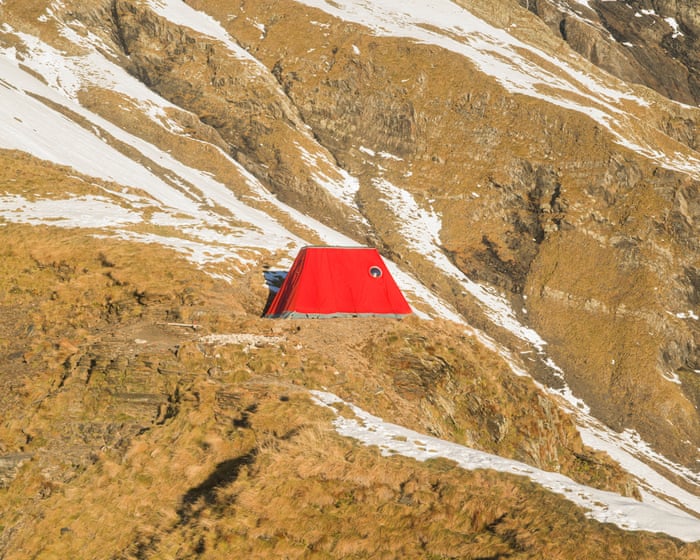Perched at 2,300 meters, Italy’s newest and most remote cultural site can be seen long before you can reach it. Appearing as a red sliver on a ridge, it first seems like a warning, then takes on a more reassuring shape—a shelter braced against the wind.
Located on a high ridge in Valbondione along the Alta Via delle Orobie, the structure faces avalanches and sudden weather changes. I viewed it from above after taking off from Rifugio Fratelli Longo near Carona, a small mountain village just over an hour’s drive from Bergamo’s GAMeC, the modern and contemporary art gallery that served as my nearest access point for the site visit.
The Frattini Bivouac is unmanned, requires no tickets, and has no staff. Anyone can enter, but only after a six-to-eight-hour climb over scree, moss, and snowfields. During my visit, I saw it only from a helicopter as part of a press preview; otherwise, the only way up is the long trek.
Inside, the space is simple: nine sleeping platforms, a wooden bench, and a skylight framing a strip of sky that becomes the only artwork on display. There are no display cases, labels, or explanations—just the temperature, silence, and altitude. Sounds behave oddly here: breathing, footsteps, rain on fabric. Unlike typical museums that protect objects from nature, this one embraces the elements.
Designed by Turin’s Studio EX in collaboration with the Italian Alpine Club, the bivouac opened this autumn as the final part of “Thinking Like a Mountain.” This phrase, coined by American ecologist Aldo Leopold, titles the museum’s two-year experiment in moving culture from galleries into the ecosystem.
According to GAMeC director Lorenzo Giusti, the idea is that curating can be a form of geological thinking—slow, enduring, and responsive to forces greater than humanity. Over two years, the project spread across Bergamo’s valleys and pre-alpine villages, with performances in old factories, installations in biodiversity areas, and sculptures in mining districts. Each piece lasted a season or a day, often accessible only on foot, and involved local communities as participants rather than spectators. The Frattini Bivouac is the project’s purest form—the point where the museum completely leaves the museum behind.
It’s also where the project’s ambitions face their toughest test in reality. The bivouac replaces a 1970s steel shelter that had become structurally unsafe and contaminated with asbestos. Though hazardous for people, the old refuge had become part of the mountain’s character—local ibex used its metal sides to scratch their horns, leaving shiny marks. The new structure had to be safe, environmentally lighter, and climate-resilient, but there’s no guarantee wildlife will accept it.
Even the architects are uncertain how the experimental materials—technical fabric, cork, and a lightweight composite frame—will hold up against animal contact over time. Altitude tests ideas as swiftly as it wears down metal.
Studio EX designed the new refuge to weigh just over two tonnes. It was airlifted to the ridge in four trips, each drop carefully balanced against the wind. The building is a paradox in all the ways its creators intended: permanent yet reversible, strong yet flexible, insulated yet breathable. Its red shell is made of technical fabric stretched like skin, and the interior is lined with cork that expands and contracts.Nestled high in the mountains, the shelter endures extreme temperatures. Solar panels on the roof provide basic lighting and emergency power outlets, but there is no heating, running water, or phone service—enough to sustain a stranded hiker, but far from comfortable. The structure is first and foremost a refuge; any artistic value is incidental.
This raises a question: if only a few hundred people can actually reach a commissioned work, does it truly serve the public?
At such heights, accessibility is never straightforward. A mountain shelter is not a luxury retreat—there are no helicopter tours or exclusive bookings—yet it remains accessible only to a select few: experienced climbers, seasoned hikers, and the occasional journalist flown in for a preview. The museum’s long-standing commitment to public access is tested here. If so few can visit, can the work still be considered public-serving? Or is this a natural conflict in ecological art—that the more intimately a piece engages with the landscape, the fewer people can experience it firsthand?
Overtourism is another concern. The Alps are facing growing recreational pressure, partly fueled by the gorpcore trend. The architects emphasize that their bivouac is a contrast to that aesthetic—lightweight, removable, and understated. Yet, even as a rejection of Instagram-friendly refuges, it risks becoming the opposite extreme: a reverse gorpcore, where peak cultural ambition, not high-performance gear, stakes its claim on the ridge.
Symbolism also comes into play. A museum perched at 2,300 meters (7,546 feet) can easily be seen as an institutional statement—a tiny red flag planted on the summit. The team is well aware of this and has repeatedly highlighted their aims: care, coexistence, and humility. But architectural statements, especially at high altitudes, can convey unintended meanings. The bivouac might be interpreted as both an act of devotion and one of pride—a structure that seeks to blend into the mountain while simultaneously leaving its mark.
Still, there is something subtly revolutionary about the Frattini Bivouac. It challenges whether culture can endure hardship and if a museum can exist where survival depends on climate, not just concept. It redefines the role of the curator from selector to adapter—to weather, terrain, and human limits.
As I watched the ridge after the helicopter departed, I was struck by how small the building appeared. Whatever else it represents, it serves as a reminder that nothing at high altitudes remains permanent—not structures, not intentions, not even the ground beneath them.
The Frattini Bivouac is located at 46°02’27.60”N 9°55’14.90”E and is open year-round. Visitors are advised to check weather and trail conditions with the Italian Alpine Club before heading out.
Frequently Asked Questions
Of course Here is a list of FAQs about a museum that requires an eighthour hike to reach designed to be clear concise and natural
General Beginner Questions
1 Is this for real A museum you have to hike eight hours to see
Yes its real The museum is intentionally located in a remote pristine natural area to create a unique and immersive experience that combines art nature and personal journey
2 Where is this museum located
The museum is typically situated in a rugged protected wilderness area such as a national park a mountain range or a remote coastal region The exact location is provided upon ticket purchase
3 What kind of art or exhibits does it have
The exhibits are often sitespecific meaning they are created to exist in harmony with the natural landscape You might find largescale land art sculptures made from natural materials installations and exhibits on the local ecology and history
4 Do I need to be an expert hiker to go
No but you do need to be in good physical condition The hike is long and strenuous so its not recommended for absolute beginners Prior dayhiking experience is highly advised
5 How much does it cost
The ticket price varies but it generally covers museum entry and often includes a contribution to trail maintenance and conservation efforts for the surrounding land
Planning Preparation Questions
6 What is the best time of year to visit
The museum is only open during seasons with safe hiking conditions typically late spring through early fall Always check the museums official website for specific opening dates and weather advisories
7 Do I need to book in advance
Yes absolutely Access is strictly limited to a small number of visitors per day to protect the environment and ensure a quality experience Reservations are mandatory and often sell out months in advance
8 What should I pack for the trip
Essentials include sturdy brokenin hiking boots a large backpack at least 34 liters of water highenergy food and snacks weatherappropriate clothing a firstaid kit a map and compass a headlamp and a emergency shelter
9 Is there water available along the trail
You must assume there is no reliable water source You are responsible for carrying all the water you




